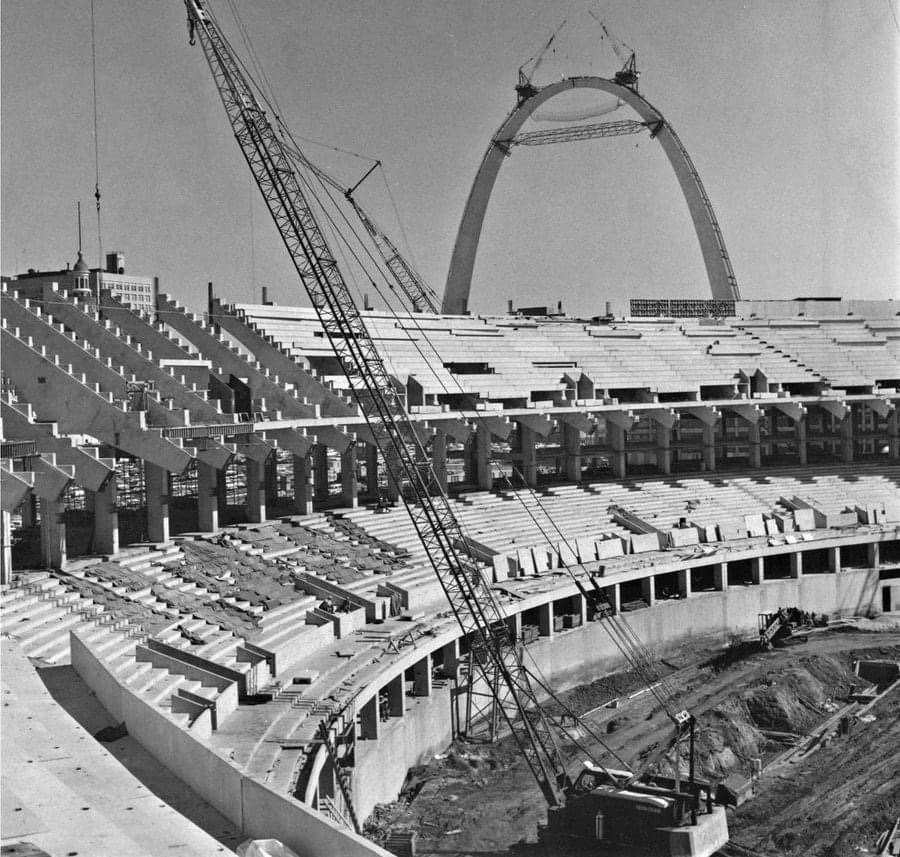A Tale of Two Landmarks
The mid-1960s in St. Louis, Missouri, was a period marked by ambitious architectural endeavors that would forever change the city’s skyline. It was during this era that two iconic structures were simultaneously coming to life: the construction of the Busch Stadium and the completion of the Gateway Arch. This historical coincidence marked a significant chapter in St. Louis’s urban and cultural development.

The Gateway Arch: A Monument to Westward Expansion
The Vision and Completion
The Gateway Arch, designed by architect Eero Saarinen, was conceived as a monument to the westward expansion of the United States. Its construction began in 1963 and was completed in 1965. This 630-foot stainless steel arch, the world’s tallest, symbolizes the gateway to the West and stands as a testament to the pioneering spirit of the early Americans.
Engineering Marvel
The construction of the Arch was an engineering marvel. The precision required to ensure that the legs, built simultaneously from either side, would meet perfectly at the top was a feat of mathematical and engineering prowess.
Busch Stadium: A New Home for the Cardinals
The Birth of a Stadium
At the same time, just a few blocks away, another significant project was underway: the construction of the Busch Stadium. The stadium was designed as the new home for the St. Louis Cardinals, one of the most storied franchises in Major League Baseball.
Construction and Design
The original Busch Stadium, also known as Busch Memorial Stadium, broke ground in 1964 and opened its doors in 1966. Its design was a circular, multi-purpose facility, a common architectural trend for stadiums during that era.
A Historic Intersection
The Photo That Captured an Era
Imagine a photograph capturing both these monumental constructions in a single frame: the Arch, a gleaming curve of steel, nearing its completion, and in the foreground, the emerging structure of the Busch Stadium. This image represents not just a moment in time but the spirit of an era – one of growth, ambition, and the American spirit.
The Impact on St. Louis
The simultaneous construction of these landmarks heralded a new era for St. Louis. The Arch became a national symbol and a major tourist attraction, while Busch Stadium would go on to host countless baseball games, including World Series victories, concerts, and events, embedding itself deeply into the cultural fabric of the city.
Legacy of the Icons
Today, these structures stand not just as physical landmarks but as symbols of a significant period in St. Louis’s history. The Gateway Arch and Busch Stadium, each iconic in their own right, together tell a story of a city’s growth and its enduring love for baseball and heritage. Their parallel construction will forever be remembered as a pivotal moment when St. Louis boldly stepped onto the national stage, showcasing its architectural ambition and cultural vibrancy.
What Inspired the Design of the Gateway Arch?
A: The Gateway Arch, designed by Eero Saarinen, was inspired by the concept of commemorating the westward expansion of the United States. Saarinen’s vision was to create a monumental structure that would symbolize a gateway, reflecting the city’s role as the ‘Gateway to the West.’ The arch’s unique catenary curve design was chosen for its elegant and structurally sound shape, representing a door to the frontier.
How Did Busch Stadium Influence St. Louis’s Sports Culture?
A: The construction of Busch Stadium marked a new era for St. Louis’s sports culture, particularly for baseball. As the home of the St. Louis Cardinals, the stadium became a central hub for baseball fans and a venue for major sporting events. It played a significant role in fostering a strong community spirit and a deep-seated love for the game, enhancing the city’s reputation as a major sports center.
Were There Any Challenges During the Construction of These Landmarks?
A: Yes, both projects faced significant challenges. For the Gateway Arch, the primary challenge was the precision required in the construction process. The legs of the arch had to be built simultaneously and meet exactly at the top, a feat that required meticulous planning and engineering. For Busch Stadium, the challenges were more related to its design as a multi-purpose facility and the need to complete it in time for the 1966 baseball season.
How Have These Landmarks Impacted Tourism in St. Louis?
A: The Gateway Arch and Busch Stadium have had a profound impact on tourism in St. Louis. The Arch, as a national monument, attracts millions of visitors annually, eager to witness this architectural marvel and learn about the nation’s westward expansion. Busch Stadium, with its rich history and significance in baseball, draws sports enthusiasts from across the country, contributing significantly to the city’s tourism industry.
What is the Legacy of These Structures in Modern St. Louis?
A: The legacy of the Gateway Arch and Busch Stadium extends beyond their physical presence. They symbolize St. Louis’s ambition and its ability to achieve grand architectural feats. The Arch remains a symbol of American pioneering spirit, while Busch Stadium continues to be a beloved landmark for baseball fans, embodying the city’s passion for sports and community gatherings.
The Enduring Significance of the Arch and Stadium
The Gateway Arch and Busch Stadium stand as testaments to a pivotal era in St. Louis’s history. They not only transformed the city’s skyline but also its cultural and social landscape. These landmarks continue to be integral to the city’s identity, reminding residents and visitors alike of St. Louis’s dynamic history and its ongoing story.
As an Amazon Associate we earn from qualifying purchases through some links in our articles.




